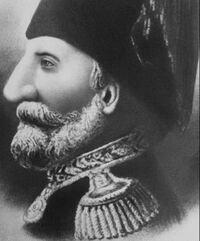محمد خسرو پاشا
محمد خسرو پاشا (ويُعرف أيضاً بإسم خوجة محمد خسرو پاشا؛ وأحياناً في المصادر الغربية بمجرد خسرو پاشا؛[1] 1769–1855) كان قپودان پاشا العثماني ("الأميرال الأكبر"/أمير البحار) في البحرية العثمانية ورجل دولة بلغ منصب الصدر الأعظم في مرحلة متأخرة من حياته العملية، بين 2 يوليو 1839 و 8 يونيو 1840 في عهد عبد المجيد الأول. إلا أنه في عقد 1820، شغل مناصب ادارية هامة في مكافحة أمراء الحرب الإقليميين (مثل محمد علي پاشا، وفي إصلاح الجيش، وإصلاح الزي العثماني.
في مصر
كان محمد خسرو ربيب كچك حسين پاشا، المصلح الذي أصبح قپودان پاشا في 1792.[1] وفي 1801، قاد خسرو پاشا قوة تركية من 6,000 جندي ساعدت البريطانيين في طرد الفرنسيين من رشيد. ولذلك، فقد عـُيـِّن الوالي العثماني على إيالة مصر،[1] وفي هذا المنصب كان عليه أن يساعد حسين پاشا في قتل أو حبس القادة المتبقين من المماليك. وكان كثير منهم قد أطلق سراحه البريطانيون أو فروا معهم، بينما احتفظ آخرون بالمنيا بين الصعيد و مصر السفلى.
ووسط هذا الجو المضطرب، حاول خسرو پاشا فض اعتصام الباش بزق الألبان الذين لم يحصلوا على رواتبهم. وقد أدى ذلك غلى شغب دفعه للهرب من القاهرة إلى دمياط، حيث اعتقله جيش مملوكي-ألباني مشترك (انظر استيلاء محمد علي على السلطة).[1] وقد عُيـِّن لاحقاً والياً على مصر مرة أخرى من قِبل محمد علي پاشا ليومين، بالرغم من أنه لم يمسك بأي سلطة حقيقية؛ وقد أقيل بعدها مباشرة.
قپودان پاشا؛ والي طرابزون
Hüsrev Pasha held the rank of قپودان پاشا of the Ottoman Navy from 1811 to 1818. He was then appointed governor of the ولاية طرابزون twice, during which time he conducted for the Black Sea region of Turkey the struggle the central Ottoman state was waging against local feudal rulers (Derebeys).
حرب الاستقلال اليونانية
أثناء حرب الاستقلال اليونانية، he was appointed Kapudan Pasha again in the end of 1822. In this role, he captured and destroyed the island of Psara in June 1824 and then moved against ساموس، where he was joined by the Egyptian fleet. During the months of July and August, several skirmishes and constant maneuvers followed between the Ottoman and Greek fleets, culminating في معركة گيرونتا، التي كانت نصراً يونانياً.
مجدد الجيش
In 1826, Husrev Pasha played vital roles both in the Auspicious Incident (the annihilation of the Janissary Corps in 1826) and in the formation of the new "Mansure Army" modeled after those of European Powers. Appointed as serasker (قائد الجيش) of the Mansure in May 1827, Husrev reformed and disciplined the corps. Himself ignorant of modern military methods, he assembled a staff of foreign experts and other personnel to assist him, the "Seraskeriye", which constituted the first staff in Ottoman history. Due to his early championing of military reform and virtual control over the new Ottoman army, Husrev was able to install many of his protégés in senior military positions. In total, Husrev's household produced more than 30 generals.[2]
تبنيه أطفال ليصبحوا ضباطاً عظام
Husrev Pasha adopted at early ages up to one hundred children, sometimes including slaves bought at market, who, after an attentive education, later became his protégés and rose to important positions in the state structure, the most notable of these being إبراهيم أدهم پاشا, a child من خيوس bought in an İzmir slave market in 1822 after the horrific مذبحة خيوس. Levy mentions that in the 27,000-strong initial Mansure Army of 1827, the direct ancestor to today's Turkish Army, the officer corps included a core group of 70-80 of Husrev Pasha's "children".[بحاجة لمصدر]
اعتماره الطربوش ليحل محل العمامة
Husrev Pasha was also instrumental for the near-abandonment of the turban واعتماد الطربوش as a universal headgear for Muslim men of the Ottoman Empire (excluding the religious classes) under السلطان محمود الثاني. He had seen the fez as worn occasionally by Tunisians and Algerians during a Mediterranean journey and introduced it للعاصمة العثمانية، from which the custom spread to all Ottoman lands including the nominal dependency of مصر. It is to be noted that dress and headgear often signified symbol-laden and politically charged statements في الأراضي التركية.[بحاجة لمصدر]
الهامش
- ^ أ ب ت ث Inalcık, Halil. Trans. by Gibb, H.A.R. The Encyclopaedia of Islam, New Ed., Vol. V, Fascicules 79-80, pp. 35 f. "Khosrew Pasha". E.J. Brill (Leiden), 1979. Accessed 13 Sept 2011.
- ^ Uyar, Mesut; Erickson, Edward (2009). A Military History of the Ottomans: From Osman to Atatürk. pp. 133–4, 145–6. ISBN 978-0-275-98876-0.
وصلات خارجية
| مناصب سياسية | ||
|---|---|---|
| سبقه Ebu Merak Mehmed Pasha |
والي مصر العثماني 22 يناير 1802 – 6 مايو 1803 |
تبعه طاهر پاشا |
| سبقه علي پاشا الطرابلسي |
والي مصر العثماني 12 مارس 1804 – 14 مارس 1804 |
تبعه خورشيد أحمد پاشا |
| سبقه محمد أمين رؤوف پاشا |
الصدر الأعظم للدولة العثمانية يوليو 1839 – 29 مايو 1841 |
تبعه محمد أمين رؤوف پاشا |
| مناصب عسكرية | ||
| سبقه قرة محمد پاشا |
قپطان البحار 1823-1827 |
تبعه طپال عزت پاشا |
| سبقه قرة محمد پاشا |
قپطان البحار 1811-1817 |
تبعه أحمد پاشا |
- Missing redirects
- Short description is different from Wikidata
- Articles with unsourced statements from July 2011
- مواليد 1769
- وفيات 1855
- أباظة
- پاشوات
- موظفون عموميون عثمانيون
- قپودان پاشوات
- عسكريون عثمانيون في حرب الاستقلال اليونانية
- عثمانيون في الحرب العثمانية المصرية (1839-1841)
- الصدور العظام للدولة العثمانية في القرن 19
- عثمانيون من أصل شركسي
- ولاة مصر العثمانيون
- قادة عسكريون عثمانيون في الحروب الثورية الفرنسية
